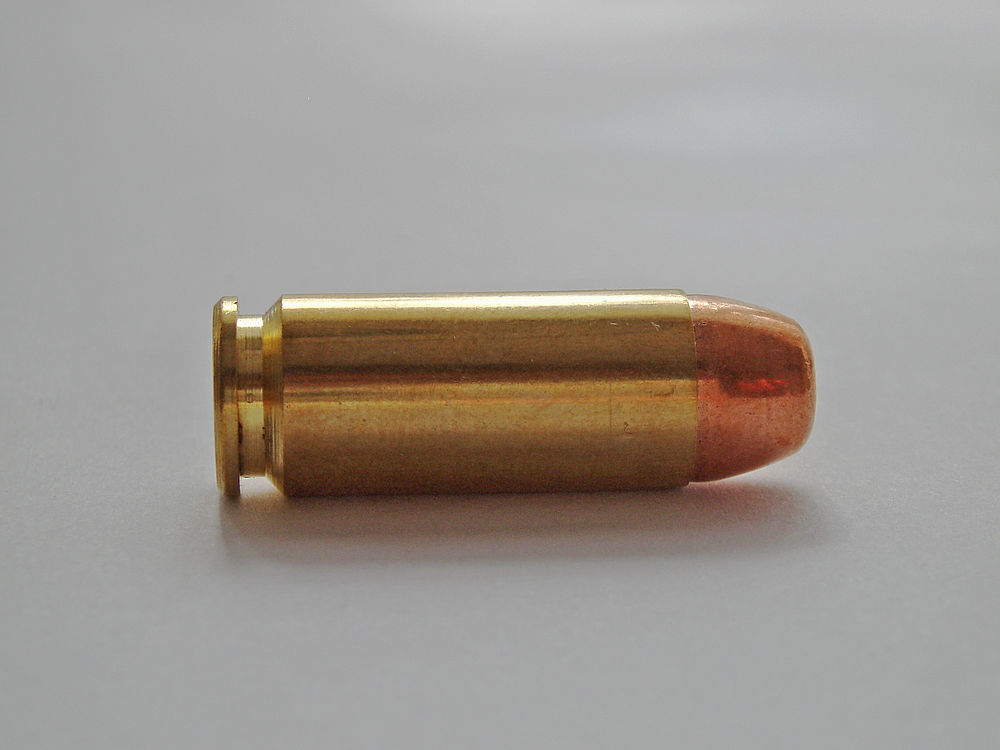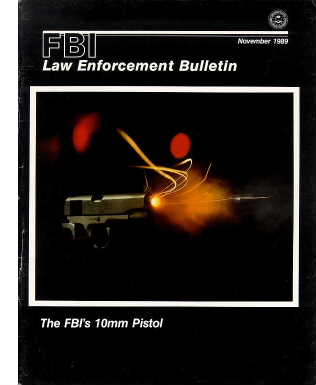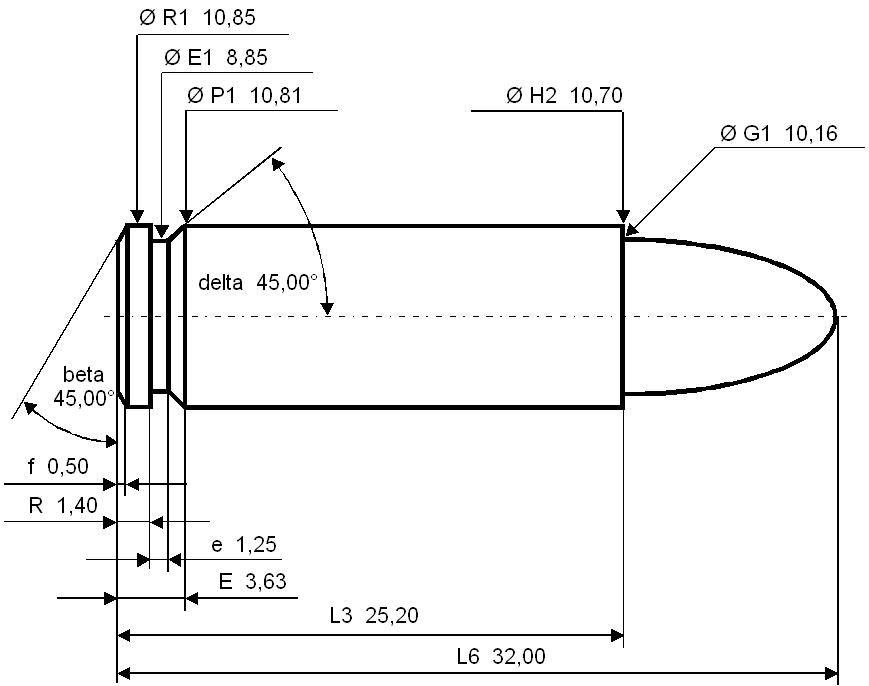¶ History

The 10mm Auto cartridge was originally drafted and championed by eminent firearms expert Lieutenant Colonel John Dean "Jeff" Cooper (May 10, 1920 – September 25, 2006; U.S.M.C., Ret.). It was designed to be a medium-velocity pistol cartridge with better external ballistics (i.e., flatter trajectory, greater range) than the .45 ACP and capable of greater stopping power than the 9×19mm Parabellum. When FFV Norma AB designed the cartridge at the behest of Dornaus & Dixon Enterprises, Inc for their Bren Ten pistol (a newly developed handgun with design inspired by the CZ 75), the company decided to increase the power over Cooper's original concept. The resulting cartridge—which was introduced in 1983 and produced since—is very powerful, containing the flat trajectory and high energy of a magnum revolver cartridge into a relatively short, versatile rimless cartridge for a semi-automatic pistol.
One of the first issues with its early acceptance and prosperity was the result of quality problems in consequence from rushed production to meet copious (some even defaulted) pre-orders of the pistol it was originally—as well as then being only—chambered for: the Bren Ten. An example being the peculiar circumstances surrounding the pistol's distribution at its primary release, leading to a number of initial Bren Tens sent to dealers and customers without magazines (the magazines themselves also had complications). The relatively high price of the Bren Ten compared to other pistols of the time (manufacturer's suggested retail price in 1986 was U.S. $500) also contributed, and the company was eventually forced to declare bankruptcy, ceasing operations in 1986 after only three years of inconsistent, substandard production. Had it not been for Colt's Patent Fire Arms Manufacturing Company making the unexpected decision in 1987 to bring out their Delta Elite pistol (a 10mm Auto version of the M1911) and later, the F.B.I.'s adoption of the caliber in 1989, the cartridge might have sunk into obsolescence, becoming an obscure footnote in firearms history.
Due to media exposure in the television series Miami Vice, where one of the lead protagonist had used the pistol as his primary signature weapon, demand for the Bren Ten increased after manufacturing ceased. In the succeeding five years, prices on the Standard Model rose to in excess of U.S. $1,400, and original magazines were selling for over U.S. $150.
The briefly field-tested the 10mm Auto using a M1911 pistol platform and a Thompson Model 1928 submachine gun before adopting the Smith & Wesson Model 1076 in 1990; a short barreled version of the Model 1026 with its slide-mounted decock/firing pin block safety supplanted by only a frame-mounted decocker. A contract was also signed with Heckler & Koch to produce a specialized quantity of the MP5 utilizing the cartridge, designated MP5/10 for use by the H.R.T. and S.W.A.T. Since 1994, both units still field the weapon and caliber to this day. During testing of the caliber in 1988, it was decided that the full-power commercial load of the 10mm Auto was the best for law enforcement usage amongst all other semi-automatic pistol cartridges of the era, but it also resulted in undesirable recoil for most agents. Thereafter, experimentations were carried out, and a specification for reduced-recoil ammunition was created; later, the requirement was submitted to the Federal Cartridge Corporation for production and followed further review. This became known as the "10mm Lite", or "10mm F.B.I." load, also currently common from various manufacturers today. Along with some pistol reliability problems increasing with this lighter load, Smith & Wesson observed that a version of the 10mm case reduced to 22 millimeters from the original 25 mm could be made with the retained performance parameters of the "10mm Lite". This altered cartridge was named the .40 Smith & Wesson. The shorter case length allowed function in a 9mm Luger chambered pistol; the advantage being that smaller-handed shooters could now have smaller-frame semi-automatic handguns with near—or in some cases, exact—10mm performance. Colloquially called the "Forty Cal" and other synonyms, this innovation has since become a common handgun cartridge among law enforcement agencies and civilians in the U.S., while the popularity of the parent 10mm Auto still exists but has contrastingly diminished. Colt, Dan Wesson Firearms, Glock, Kimber Manufacturing, Nighthawk Custom, Smith & Wesson, STI International and Tanfoglio are some of the few manufacturers that still offer handguns in 10mm Auto.
The 10mm outperforms the .40 S&W by 61–76 m/s (200–250 ft/s) for similar bullet weights when using available full power loads, as opposed to the "10mm F.B.I." level loads still found in some ammunition catalogs. This is due to the 10mm Auto's higher S.A.A.M.I. pressure rating of 37,500 psi (259 MPa), as opposed to 35,000 psi (240 MPa) for the .40 S&W, and the larger case capacity, which allows the use of heavier bullets and more smokeless powder.
¶ FBI Testing & Selection

November 1989 FBI Law Enforcement Bulletin - 10mm Testing (PDF)
While the 10mm Auto and the Bren Ten caused quite a stir when it was first introduced, it wasn't until a number of years after Dornaus & Dixon filed bankruptcy that the cartridge really exploded into popularity.
The first boost came when Colt chambered the 10mm in their 1911 Government Model. Up to this point the only 10mm gun was the Bren Ten and with the Bren out of the picture the cartridge was just about dead. The Colt Delta Elite saved the 10mm Auto and continues to be one of the most popular guns built for the 10mm.
While Colt's "adoption" of the 10mm was definately significant, what really pushed the cartridge into the spot light was the FBI's selection of the 10mm Auto as its standard service cartridge. Once the FBI declared that the 10mm Auto was "the best law enforcement cartridge available" the 10mm became "THE" hot police cartridge and law enforcement agencies across the country started looking at it for their own needs.
The November 1989 issue of "FBI Law Enforcement Bulletin" discusses the agency's testing process and subsequent decision to select the 10mm Auto as its primary cartridge for its agents. As most people know what the FBI ended up with was what is commonly known as the "FBI Lite." Originally the two cartridges being tested were the 9mm Winchester 147gn JHP and Remington .45 Auto 185gn JHP, both doing about 950fps. The "new" 10mm Auto was added to the testing, but it was felt the recoil would be unmanagable for many agents and so the FBI Firearms Training Unit handloaded their own 10mm ammo using a 180gn JHP loaded to the same 950fps as the other two loads. This load marginally outperformed the .45 load, but still kept the potential for far greater power in its original loading if so desired.
¶ Dimensions

The 10mm Auto has 1.56 milliliter (24 grain H2O) cartridge case capacity.
Common rifling twist rate for this cartridge is 381 mm (1 in 15 inches), 5 grooves, Ø lands = 9.91 mm, Ø grooves = 10.16 mm, and land width = 4.47 mm. A large pistol primer is used.
The Commission Internationale Permanente pour l'Epreuve des Armes à Feu Portatives (C.I.P.; Permanent International Commission for Firearms Testing) rulings indicate a maximum pressure of 230.0 MPa (33,360 psi). In C.I.P. regulated countries, every pistol/cartridge combination is required to be proofed at 130% of this maximum C.I.P. pressure to certify for sale to consumers.
The Sporting Arms and Ammunition Manufacturers' Institute (S.A.A.M.I.) pressure limit for the 10mm Auto is set at 37,500 psi (258.55 MPa).
¶ 3D Model
A 3D Model (STL) can be obtained from : 10MM Model
¶ Performance
At full potential, the 10mm Auto produces energy slightly higher than an average .357 Magnum load and below standard .41 Magnum rounds. The cartridge is considered to be high-velocity, giving it a less-curved flight path (also termed "flat-shooting") relative to other handgun cartridges. In its lighter loadings, the 10mm Auto is an exact duplicate of the .40 S&W cartridge. More powerful loadings can equal or exceed the performance of the .357 Magnum, and retain more kinetic energy at 100 yards than the .45 ACP has at the muzzle.
Some commercial loadings are as follows:
-
.357 Magnum: 917 J (676 ft·lbf) for 11.7 g (180 gr) at 400 m/s (1,300 ft/s). Free recoil energy: 13.7 J (10.1 ft·lbf)
-
10mm Auto: 1,020 J (750 ft·lbf) for 13.0 g (200 gr) at 400 m/s (1,300 ft/s). Free recoil energy: 16.4 J (12.1 ft·lbf)
-
.41 Magnum: 1,272 J (938 ft·lbf) for 16.2 g (250 gr) at 400 m/s (1,300 ft/s). Free recoil energy: 31.0 J (22.9 ft·lbf)
The loads listed above are from a boutique manufacturer of high performance ammunition and are about maximum for S.A.A.M.I. established pressure levels in each cartridge. Free recoil energy computed assuming a 1.1 kilograms (40 oz) handgun. Most major ammunition manufacturers offer 10mm loads closer in performance to the "F.B.I. Load" than the full-power 10mm; these still contain sufficient power for defense applications, but their recoil is more comparable to that of the .45 ACP in similar guns. However, some companies do continue to offer the original full-power ammunition.